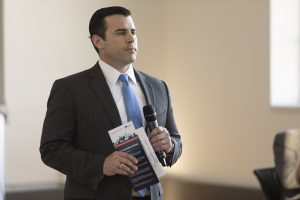 In Nick Armstrong’s role as the managing director of research and data at the Institute for Veterans and Military Families (IVMF), data takes on a more significant role: his team collects data and leads research to inform the delivery of educational and training programs that advance our nation’s veterans and the military-connected community.
In Nick Armstrong’s role as the managing director of research and data at the Institute for Veterans and Military Families (IVMF), data takes on a more significant role: his team collects data and leads research to inform the delivery of educational and training programs that advance our nation’s veterans and the military-connected community.
Armstrong directs IVMF’s multi-disciplinary team of applied social scientists, evaluators, and data engineers to crunch the numbers and conduct applied research that empower government, industry, and philanthropic decision making on veteran- and family-related issues.
Those issues include addressing how veterans transition from active duty to civilian life, and their pursuit of not just a job that pays the bills, but a satisfying and meaningful career that suits their skills.
This model of translating research and data into impactful practice, programs, and policy would be a differentiator for IVMF, and is what drew Armstrong to the role early on in working with J. Michael Haynie, IVMF’s founder and executive director and the Vice Chancellor.
“It was a great fit for my career and my passions. As an institution, we measure the delivery of our programs, and that feeds back into our research. We combine research with the data to offer programs that help us stay on the cutting edge,” said Armstrong, who earned his M.P.A. and Ph.D. degrees with concentrations in public administration and national security policy from the Maxwell School of Citizenship and Public Affairs.
When Armstrong first joined IVMF in 2014, veteran unemployment was a persistent concern. But as the economy recovered, less data was being collected on how satisfied veterans were with their jobs or their career paths.
After surveying veterans on their career goals and aspirations, Armstrong and his team quickly realized a shift in philosophy was required. The resulting change led to offering more education, training, and credentialing opportunities in high, long-term growth career opportunities, particularly in fields like STEM (science, technology, engineering, and mathematics).
“With our military, they are the largest workforce across America, and they consist of a ready-made pool of workers. We needed to design programs where we knew there was a market, a need, and a demand for specific careers and jobs. We focused on the barriers they would face, and how we can influence or design policies to reduce those barriers and create opportunities. We’re focused on helping them gain employment, not just post-military but for life,” Armstrong said.
Read The Full Story On How Nick Uses Data To Help Veterans
